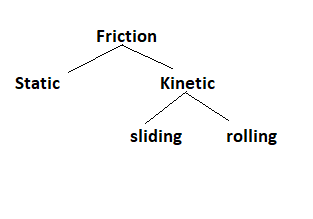PDF chapter test TRY NOW
We walk on roads without falling. But, we tend to fall when we walk on wet surfaces. Why?
Because of the friction between our feet and the surface, we can safely walk on the roads. However, when we walk on a damp surface, the friction is reduced. As a result, we tend to fall.
When two or more bodies in contact move or tend to move relative to one another, frictional force or friction is created. At all times, friction acts in the opposite direction of the moving body. The geometrical dissimilarities of the bodies' surfaces, which are in relative motion, produce this force. The following are some of the effects that friction can have,
- Friction opposes relative motion.
- It causes wear and tear of materials.
- It also produces heat.
Types of friction:
Friction can be classified into two types,
- Static friction
- Kinetic friction
Kinetic friction can further be classified into sliding friction and rolling friction.

Types of friction
Static friction: The friction experienced between static bodies or bodies at rest. A box of heavy load is very difficult to lift or move, due to static friction.
Kinetic friction: Friction between two or more moving bodies. It can be classified as sliding friction and rolling friction.
- Sliding friction: If a body slides over the surface of another body, the friction acting between surfaces in contact can be termed as sliding friction.
- Rolling friction: If a body rolls over the surface of another body, the friction between the surfaces is called rolling friction.
Rolling friction is lesser than sliding friction. Hence, we have tyres in vehicles, trolleys so that friction can be lesser and motion of the body can be more.
